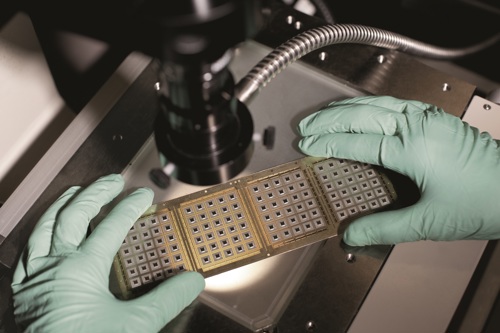First, its Bergquist gap filler TGF 2900LVO is a silicone-based, two-component room temperature curable gap filler suitable for use in a wide range of electronic assembly applications. Thanks to its low volatile outgassing, Bergquist gap filler TGF 2900LVO is ideal for applications sensitive to siloxane outgassing.
The filler benefits from what the company calls an ‘ultra-thin bondline’ to help optimise heat dissipation. It is also said to have good shot consistency.
“Representing a new generation of Henkel gap fillers, TGF 2900LVO demonstrates superior performance that makes it an outstanding choice for automotive control modules. These designs are ever evolving and find a versatile solution in the possibility of ultra-thin bondline thickness of TGF 2900LVO, lowering the overall thermal resistivity of the system,” said Bart Van Eeghem, business development manager at Henkel.

Also focusing on thermal performance is a die attach adhesive that provides high thermal capability to enable superior operation of power semiconductor packages. With 30 W/m-K thermal conductivity – said to be among the market’s highest thermal performance without sintering – Loctite Ablestik 6395T allows integration of back-side metallised or bare silicon (Si) die.
Elevated operational temperature is a key factor influencing die performance, so thorough heat dissipation helps ensure functional execution and long-term reliability. Most high-power semiconductor applications, like those found in electric vehicles, industrial automation systems, and 5G infrastructure components, also demand good electrical conductivity. Too much electrical resistance between the die and the package can result in energy loss and reduce the device’s energy efficiency.
Henkel’s global market segment head for semiconductor packaging materials, Ramachandran Trichur, explains the mechanism of heat transfer from the die and why material selection is critical: “For most high-power semiconductor packages, the primary path for heat dissipation from the device is through the die attach material. Because the material is in direct contact with the die, its thermal characteristics – which include material thickness, thermal conductivity, and thermal resistance – are the most important. Loctite Ablestik 6395T’s 30 W/m-K bulk thermal conductivity provides excellent heat transfer for metallised or bare Si die.”
In addition to its enabling electrical and thermal characteristics, Loctite Ablestik 6395T provides several processability, sustainability, and reliability advantages, including high reliability: it meets automotive grade 0 thermal cycling and MSL 1 reliability standards on die sizes up to 3.0 mm x 3.0 mm. Its volatile organic compound (VOC) content on cure is less than 5%.
Trichur added: “While electrical and thermal capability are top priorities, a streamlined bill of materials is also important for customers. Loctite Ablestik 6395T allows metallised or non-metallised die integration, delivers lead frame flexibility, and allows for a wide die size range – all using a high-reliability formulation.”










